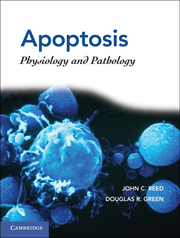Book contents
- Frontmatter
- Contents
- Contributors
- Part I General Principles of Cell Death
- Part II Cell Death in Tissues and Organs
- 11 Cell Death in Nervous System Development and Neurological Disease
- 12 Role of Programmed Cell Death in Neurodegenerative Disease
- 13 Implications of Nitrosative Stress-Induced Protein Misfolding in Neurodegeneration
- 14 Mitochondrial Mechanisms of Neural Cell Death in Cerebral Ischemia
- 15 Cell Death in Spinal Cord Injury – An Evolving Taxonomy with Therapeutic Promise
- 16 Apoptosis and Homeostasis in the Eye
- 17 Cell Death in the Inner Ear
- 18 Cell Death in the Olfactory System
- 19 Contribution of Apoptosis to Physiologic Remodeling of the Endocrine Pancreas and Pathophysiology of Diabetes
- 20 Apoptosis in the Physiology and Diseases of the Respiratory Tract
- 21 Regulation of Cell Death in the Gastrointestinal Tract
- 22 Apoptosis in the Kidney
- 23 Physiologic and Pathological Cell Death in the Mammary Gland
- 24 Therapeutic Targeting Apoptosis in Female Reproductive Biology
- 25 Apoptotic Signaling in Male Germ Cells
- 26 Cell Death in the Cardiovascular System
- 27 Cell Death Regulation in Muscle
- 28 Cell Death in the Skin
- 29 Apoptosis and Cell Survival in the Immune System
- 30 Cell Death Regulation in the Hematopoietic System
- 31 Apoptotic Cell Death in Sepsis
- 32 Host–Pathogen Interactions
- Part III Cell Death in Nonmammalian Organisms
- Plate section
- References
30 - Cell Death Regulation in the Hematopoietic System
from Part II - Cell Death in Tissues and Organs
Published online by Cambridge University Press: 07 September 2011
- Frontmatter
- Contents
- Contributors
- Part I General Principles of Cell Death
- Part II Cell Death in Tissues and Organs
- 11 Cell Death in Nervous System Development and Neurological Disease
- 12 Role of Programmed Cell Death in Neurodegenerative Disease
- 13 Implications of Nitrosative Stress-Induced Protein Misfolding in Neurodegeneration
- 14 Mitochondrial Mechanisms of Neural Cell Death in Cerebral Ischemia
- 15 Cell Death in Spinal Cord Injury – An Evolving Taxonomy with Therapeutic Promise
- 16 Apoptosis and Homeostasis in the Eye
- 17 Cell Death in the Inner Ear
- 18 Cell Death in the Olfactory System
- 19 Contribution of Apoptosis to Physiologic Remodeling of the Endocrine Pancreas and Pathophysiology of Diabetes
- 20 Apoptosis in the Physiology and Diseases of the Respiratory Tract
- 21 Regulation of Cell Death in the Gastrointestinal Tract
- 22 Apoptosis in the Kidney
- 23 Physiologic and Pathological Cell Death in the Mammary Gland
- 24 Therapeutic Targeting Apoptosis in Female Reproductive Biology
- 25 Apoptotic Signaling in Male Germ Cells
- 26 Cell Death in the Cardiovascular System
- 27 Cell Death Regulation in Muscle
- 28 Cell Death in the Skin
- 29 Apoptosis and Cell Survival in the Immune System
- 30 Cell Death Regulation in the Hematopoietic System
- 31 Apoptotic Cell Death in Sepsis
- 32 Host–Pathogen Interactions
- Part III Cell Death in Nonmammalian Organisms
- Plate section
- References
Summary
Introduction
The hematopoietic system is a dynamic multilineage organ, from which we can gain insights into the physiologic roles of cell death pathways. The role of hematopoiesis is to produce blood cells under normal and stress conditions throughout the lifespan of an organism. In humans, effective function of the hematopoietic system entails the steady and regulated production of erythrocytes, which carry oxygen; platelets, which prevent bleeding; and granulocytes, monocytes, and lymphocytes, which are required for host defense. Remarkably, these varied cell types are derived from a common ancestor, the hematopoietic stem cell (HSC). HSCs are known for certain key properties: they are long-lived and self-renewing and give rise to a steady supply of multipotential progenitor cells (MPPs) that are committed to undergo differentiation. MPPs in turn give rise to progenitors with a progressively restricted developmental potential; these undergo regulated expansion and, eventually, commitment to terminal differentiation. The terminal differentiation program is characterized by decreased proliferation or mitotic arrest, global changes in gene expression, and cellular remodeling. Finally, cells that have fulfilled their purpose, or senescent cells, are cleared from the body to make room for new cells, or after a stress response to re-establish homeostasis.
- Type
- Chapter
- Information
- ApoptosisPhysiology and Pathology, pp. 350 - 362Publisher: Cambridge University PressPrint publication year: 2011

